Microman
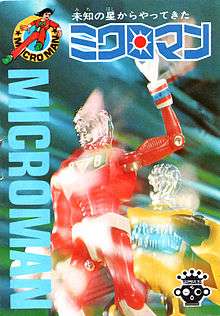 A scan of the cover of a Microman catalog from 1976. | |
| Type | Action figure |
|---|---|
| Inventor | Takara |
| Company | Takara/Takara Tomy |
| Country |
|
| Availability | 1974–2007 |
| Materials | Plastic/Die-cast |
Microman Aka Balli Micro (ミクロマン Mikuroman) was a science fiction toy line created, manufactured and marketed by Takara Co., Ltd. from 1974 to 1984 as well as from 1998 to 2007. At the core of the Microman line was a series of 3.75-inch-tall (9.5 cm) action figures with accompanying vehicles, robots, playsets and accessories. Unlike other toylines at the time, Microman figures were marketed as being the “actual” size of the cyborg beings that were replicas of real “Micro” beings that hailed from the fictional planet known as “Micro Earth” and disguised themselves as action figures to hide on planet Earth.[1][2][3][4]
Description
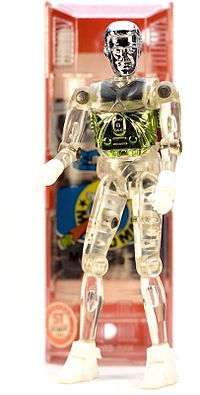
The core of the Microman line consisted of 3.75-inch-tall (9.5 cm) action figures which were known for their high number of articulation points relative to other toys of similar size/scale in the 1970s. The toy line also included vehicles, robots, playsets and accessories. Many of the Microman toys used interchangeable 5-millimetre (0.20 in) connectors and ports that allowed parts to be transferred and connected between different toys.[5][6][7][8][9]
The Microman toy line was licensed and released in the United States by Mego Corporation as the Micronauts from 1976–1980.[10][11][12][13]
Some of the transforming Microman toys and vehicles from the Micro Change series created within the 1980s New Microman toy line were licensed by Hasbro—along with other similar transforming toys from Takara’s Diaclone toy line—in the 1980s to be a part of Hasbro’s Transformers toy line in the United States.[14][15][16]
Microman toy line history in Japan
Classic Microman (1974-1980)
Takara first released Microman toys in Japan in 1974 as a smaller version of their popular 8-inch-tall (20 cm) & 12-inch-tall (30 cm) 1972 Henshin Cyborg (Transforming Cyborg) line. Henshin Cyborg figures were based on 8-inch-tall (20 cm) & 12-inch-tall (30 cm) Combat Joe figures—which themselves were based on Hasbro’s G.I. Joe figures—with their bodies molded in clear plastic, exposing their inner workings and supposed cybernetic parts.[1][2][17][18]
By downscaling their size, Takara sought to create the Microman line to offset the sheer cost of producing a full line of plastic-based 8-inch-tall (20 cm) & 12-inch-tall (30 cm) figures and related playsets as well as acknowledging that basic living space is limited—and considered a premium—to most Japanese households. Smaller Microman figures would not only cost less to produce during the energy crisis of the 1970s, the line’s smaller scale would also take up less physical space in a household and thus be more attractive to space conscious consumers in the Japanese market.[3][4]
Microman Zone (1974)

The first 1974 series of toys was called Microman Zone and included four figures—notable for their unique barefoot design when compared to later releases—and several vehicles such as the MIC-1 Space Buggy, MIC-2 Bulk Lifter, MIC-3 Sky Roader and the M115 Conning Tower Base. Additional vehicles were sold as “Micro-Kit Machine Series” sets which required assembly prior to use.[19][20]
Project Victory (1975)
Following the success of the first 1974 Microman Zone series, Takara completely revamped and expanded the Microman concept to be a stand-alone line on its own and not merely a smaller-scale version of their Henshin Cyborg line. The formerly barefoot original Microman figures now were given sturdier “cybernetic feet” and all figures now contained standard 5-millimetre (0.20 in) ports which allowed for interchangeability between sets and figures. Takara also introduced a new line of die-cast figures dubbed Super Steel Microman and even introduced a new line of “enemy” figures dubbed the Acroyears. Additionally, all figures were now identified by a new alphanumeric figure-type designation system—such as M10X, M11X, M12X, M20X, M21X, M22X, etc.…—across the whole line as well being given formal, character names such as George (M101), Jack (M102), Jesse (M103) and John (M104).[21][22]
Spy Magician (1976)
In addition to new vehicles and figures—such as Spy Magician (M13X & M14X)—Takara introduced a new class of figure dubbed the Titans which employed a magnetic ball/joint system that allowed for a new level of interchangeability between toys. Japanese pop-culture character tie-in toys were also released—such as Microman Jeeg, Robotman Gakeen and Robotman Mechadon—which helped expand Takara’s line beyond its own in-house characters and opened the door to greater licensing opportunities for their designs.[23][24]
Microman Command (1977)
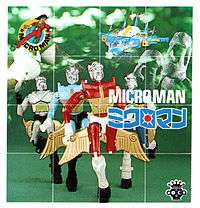
1977 was arguably the most successful year for the original Microman line with manga being published in TV Magazine, a children’s oriented magazine published by Kodansha Ltd. It also saw the introduction of the Microman Command line of figures which each came in its own unique capsule case—shaped like Easter Island figures, the Statue of Liberty, etc.…—and even included the first female figure in the line: Lady Command (M18X).[25][26]
Police Keeper (1978)
With the release of Star Wars in 1977, the market for science fiction merchandise became increasingly filled with competing science fiction related products. New figures such as the Police Keeper (M23X), Micro Knight MC-X and Cosmo Satan Arden (A35X) built on the success of prior Microman action figure releases. But Takara’s attempts to expand the Microman line concept with the Micro Hoodman (H70X) and construction/building playset Play Build line of toys with the large-sized Build Base playset were not that well received. Lack of a positive response to the new line was strong enough that previously announced toys in the line—such as the remote control Hoodman spaceship Hoodman's RCB Noah—were cancelled.[27][28]
Rescue Command (1979)

With the line in a slump, Takara attempted to revive the line with the new Rescue Command series of toys and action figures. At the core of the Rescue Command was the new Rescue Secret Base and a new background story on the Rescue Command that explained the whole “rescue” theme of the whole line.[29][30]
Punch & Blizzard Man (1980)
1980 was the last year for the original Microman line and showed Takara moving away from the trend of releasing 3.75-inch-tall (9.5 cm) figures and instead focusing on larger-sized toys, robots and sets that all contained some sort of “gimmick” to them. Gimmicks included the Microman Punch (P.0X) figure whose arm could be wound up to “punch” and Microman Blizzard (B-X) series of figures that contained a battery-powered fan.[31][32]
Microman 3.75-inch-tall (9.5 cm) Action Figures (1974-1980)
Below is a basic overview list documenting classic Microman 3.75-inch-tall (9.5 cm) action figure releases from 1974 to 1980. This is not meant to be a comprehensive list of all classic Microman releases/variants but rather a high-level overview of Takara’s 3.75-inch-tall (9.5 cm) Microman line offerings.[33][34][35][36][37][38][39]
| ID | Name | Type | 1st Color | 2nd Color | Opacity | Material | Size/Scale | Date | Series |
|---|---|---|---|---|---|---|---|---|---|
| Clear | Clear | Plastic | 3.75-inch (9.5 cm) | June 1974 | Microman Zone | ||||
| Yellow | Clear | Plastic | 3.75-inch (9.5 cm) | June 1974 | Microman Zone | ||||
| Blue | Clear | Plastic | 3.75-inch (9.5 cm) | June 1974 | Microman Zone | ||||
| Orange | Clear | Plastic | 3.75-inch (9.5 cm) | June 1974 | Microman Zone | ||||
| M101 | George | Clear | Clear | Plastic | 3.75-inch (9.5 cm) | October 1974 | Project Victory | ||
| M102 | Jack | Yellow | Clear | Plastic | 3.75-inch (9.5 cm) | October 1974 | Project Victory | ||
| M103 | Jesse | Blue | Clear | Plastic | 3.75-inch (9.5 cm) | October 1974 | Project Victory | ||
| M104 | John | Orange | Clear | Plastic | 3.75-inch (9.5 cm) | October 1974 | Project Victory | ||
| M111 | Bobson | Blue | White | Solid | Plastic | 3.75-inch (9.5 cm) | March 1975 | Project Victory | |
| M112 | Barnes | White | Light Blue | Solid | Plastic | 3.75-inch (9.5 cm) | March 1975 | Project Victory | |
| M113 | Bobby | Red | White | Solid | Plastic | 3.75-inch (9.5 cm) | March 1975 | Project Victory | |
| M114 | Blacky | Black | Yellow | Solid | Plastic | 3.75-inch (9.5 cm) | March 1975 | Project Victory | |
| M121 | Mason | Red | White | Solid | Plastic | 3.75-inch (9.5 cm) | March 1975 | Project Victory | |
| M122 | Michael | Light Blue | White | Solid | Plastic | 3.75-inch (9.5 cm) | March 1975 | Project Victory | |
| M123 | Miller | Green | White | Clear | Plastic | 3.75-inch (9.5 cm) | March 1975 | Project Victory | |
| M124 | Max | Yellow | White | Solid | Plastic | 3.75-inch (9.5 cm) | March 1975 | Project Victory | |
| M201 | Robin | Super Steel Microman | Red | Chrome | Solid | Die cast | 3.75-inch (9.5 cm) | March 1975 | Project Victory |
| M202 | Robert | Super Steel Microman | Green | Chrome | Solid | Die cast | 3.75-inch (9.5 cm) | March 1975 | Project Victory |
| M203 | Rocky | Super Steel Microman | Blue | Chrome | Solid | Die cast | 3.75-inch (9.5 cm) | March 1975 | Project Victory |
| M211 | Ken | Super Steel: Dash Wing Type | Yellow | Chrome | Solid | Die cast | 3.75-inch (9.5 cm) | August 1975 | Project Victory |
| M212 | Kelly | Super Steel: Dash Wing Type | Green | Chrome | Solid | Die cast | 3.75-inch (9.5 cm) | August 1975 | Project Victory |
| M213 | Kim | Super Steel: Dash Wing Type | Blue | Chrome | Solid | Die cast | 3.75-inch (9.5 cm) | August 1975 | Project Victory |
| M221 | Robin | Super Steel: Hand Bazooka Type | Red | Chrome | Solid | Die cast | 3.75-inch (9.5 cm) | September 1975 | Project Victory |
| M222 | Robert | Super Steel: Hand Bazooka Type | Green | Chrome | Solid | Die cast | 3.75-inch (9.5 cm) | September 1975 | Project Victory |
| M223 | Rocky | Super Steel: Hand Bazooka Type | Blue | Chrome | Solid | Die cast | 3.75-inch (9.5 cm) | September 1975 | Project Victory |
| A301 | Red Star | Acroyear | Red | Black | Solid | Die cast/Plastic | 3.75-inch (9.5 cm) | April 1975 | Project Victory |
| A302 | Silver Star | Acroyear | Silver | Black | Solid | Die cast/Plastic | 3.75-inch (9.5 cm) | April 1975 | Project Victory |
| A303 | Blue Star | Acroyear | Blue | Black | Solid | Die cast/Plastic | 3.75-inch (9.5 cm) | April 1975 | Project Victory |
| A311 | Mad Pink | Acroyear 2 | Red | Black | Solid | Die cast/Plastic | 3.75-inch (9.5 cm) | November 1975 | Project Victory |
| A312 | Mad Green | Acroyear 2 | Green | Black | Solid | Die cast/Plastic | 3.75-inch (9.5 cm) | November 1975 | Project Victory |
| A313 | Mad Blue | Acroyear 2 | Blue | Black | Solid | Die cast/Plastic | 3.75-inch (9.5 cm) | November 1975 | Project Victory |
| M131 | Dick | Blue | Black | Solid | Plastic | 3.75-inch (9.5 cm) | June 1976 | Spy Magician | |
| M132 | Dan | Red | White | Solid | Plastic | 3.75-inch (9.5 cm) | June 1976 | Spy Magician | |
| M133 | Danny | Black | Red | Solid | Plastic | 3.75-inch (9.5 cm) | June 1976 | Spy Magician | |
| M133 | David | Green | White | Solid | Plastic | 3.75-inch (9.5 cm) | June 1976 | Spy Magician | |
| M141 | Henry | White | Blue | Solid | Plastic | 3.75-inch (9.5 cm) | June 1976 | Spy Magician | |
| M142 | Hudson | Green | Black | Solid | Plastic | 3.75-inch (9.5 cm) | June 1976 | Spy Magician | |
| M143 | Holmes | Yellow | Blue | Solid | Plastic | 3.75-inch (9.5 cm) | June 1976 | Spy Magician | |
| M144 | Howard | Black | Yellow | Solid | Plastic | 3.75-inch (9.5 cm) | June 1976 | Spy Magician | |
| A321 | Devil | President Acroyear | Blue | Light Blue | Solid | Plastic | 3.75-inch (9.5 cm) | October 1976 | Spy Magician |
| A322 | Satander | President Acroyear | Green | Light Green | Solid | Plastic | 3.75-inch (9.5 cm) | October 1976 | Spy Magician |
| A323 | Demon | President Acroyear | Red | Blue | Solid | Plastic | 3.75-inch (9.5 cm) | October 1976 | Spy Magician |
| M151 | East | Command 1 | Light Blue | Black | Solid | Plastic | 3.75-inch (9.5 cm) | April 1977 | Microman Command |
| M152 | Eric | Command 1 | Red | White | Solid | Plastic | 3.75-inch (9.5 cm) | April 1977 | Microman Command |
| M153 | Elder | Command 1 | Light Blue | White | Clear | Plastic | 3.75-inch (9.5 cm) | April 1977 | Microman Command |
| M154 | Evan | Command 1 | Black | Yellow | Solid | Plastic | 3.75-inch (9.5 cm) | April 1977 | Microman Command |
| M161 | Sheriff | Command 2 | Blue | White | Solid | Plastic | 3.75-inch (9.5 cm) | May 1977 | Microman Command |
| M162 | Sander | Command 2 | Orange | Black | Solid | Plastic | 3.75-inch (9.5 cm) | May 1977 | Microman Command |
| M163 | Sander | Command 2 | Green | Yellow | Clear | Plastic | 3.75-inch (9.5 cm) | May 1977 | Microman Command |
| M164 | Sammy | Command 2 | Grey | Black | Solid | Plastic | 3.75-inch (9.5 cm) | May 1977 | Microman Command |
| M171 | Takuya | Command 3 | Red | Black | Solid | Plastic | 3.75-inch (9.5 cm) | December 1977 | Microman Command |
| M172 | Tetsuya | Command 3 | Dark Grey | Dark Grey | Solid | Plastic | 3.75-inch (9.5 cm) | December 1977 | Microman Command |
| M173 | Tatsuya | Command 3 | White | Blue | Solid | Plastic | 3.75-inch (9.5 cm) | December 1977 | Microman Command |
| M174 | Tsuyoshi | Command 3 | Blue | Yellow | Solid | Plastic | 3.75-inch (9.5 cm) | December 1977 | Microman Command |
| M181 | Ann | Lady Command | Red | White | Solid | Plastic | 3.75-inch (9.5 cm) | December 1977 | Microman Command |
| M182 | Alice | Lady Command | Red | White | Solid | Plastic | 3.75-inch (9.5 cm) | December 1977 | Microman Command |
| M183 | Annie | Lady Command | Green | Orange | Solid | Plastic | 3.75-inch (9.5 cm) | December 1977 | Microman Command |
| M184 | Ai | Lady Command | Pink | Black | Solid | Plastic | 3.75-inch (9.5 cm) | December 1977 | Microman Command |
| M231 | Arnold | Red | White | Solid | Plastic | 3.75-inch (9.5 cm) | October 1978 | Police Keeper | |
| M232 | Arthur | Blue | White | Solid | Plastic | 3.75-inch (9.5 cm) | October 1978 | Police Keeper | |
| M233 | Alex | Green | Yellow | Clear | Plastic | 3.75-inch (9.5 cm) | October 1978 | Police Keeper | |
| M234 | Anthony | Black | Yellow | Solid | Plastic | 3.75-inch (9.5 cm) | October 1978 | Police Keeper | |
| M235 | Aaron | Orange | White | Clear | Plastic | 3.75-inch (9.5 cm) | October 1978 | Police Keeper | |
| M236 | Alan | White | Light Blue | Solid | Plastic | 3.75-inch (9.5 cm) | October 1978 | Police Keeper | |
| A351 | Heller | Cosmo Satan Arden | Red | Black | Solid | Die cast/Plastic | 3.75-inch (9.5 cm) | May 1978 | Police Keeper |
| A352 | Rager | Cosmo Satan Arden | Silver | Black | Solid | Die cast/Plastic | 3.75-inch (9.5 cm) | May 1978 | Police Keeper |
| A353 | Vulger | Cosmo Satan Arden | Blue | Black | Solid | Die cast/Plastic | 3.75-inch (9.5 cm) | May 1978 | Police Keeper |
| MC8 | Micro Knight | Silver | Solid | Plastic | 3.75-inch (9.5 cm) | February 1979 | Police Keeper | ||
| MC9 | Micro Knight | Gold | Solid | Plastic | 3.75-inch (9.5 cm) | February 1979 | Police Keeper | ||
| MC10 | Micro Knight | Black | Solid | Plastic | 3.75-inch (9.5 cm) | February 1979 | Police Keeper | ||
| MC11 | Micro Knight | Blue | Solid | Plastic | 3.75-inch (9.5 cm) | July 1979 | Police Keeper | ||
| MC12 | Micro Knight | Copper | Solid | Plastic | 3.75-inch (9.5 cm) | July 1979 | Police Keeper | ||
| MC13 | Micro Knight | Green | Solid | Plastic | 3.75-inch (9.5 cm) | July 1979 | Police Keeper | ||
| H701 | Hans | Micro Hoodman | Blue | White | Solid | Plastic | 3.15-inch (8.0 cm) | March 1978 | Police Keeper |
| H702 | Regan | Micro Hoodman | Yellow | Black | Solid | Plastic | 3.15-inch (8.0 cm) | March 1978 | Police Keeper |
| H703 | Heimlich | Micro Hoodman | Green | White | Solid | Plastic | 3.15-inch (8.0 cm) | March 1978 | Police Keeper |
| H711 | Shultz | Micro Hoodman | Red | White | Solid | Plastic | 3.15-inch (8.0 cm) | March 1978 | Police Keeper |
| H712 | Rudolf | Micro Hoodman | White | Blue | Solid | Plastic | 3.15-inch (8.0 cm) | March 1978 | Police Keeper |
| H713 | Earhart | Micro Hoodman | Blue | Black | Solid | Plastic | 3.15-inch (8.0 cm) | March 1978 | Police Keeper |
| H721 | Heilman | Micro Hoodman | Gold | White | Solid | Plastic | 3.15-inch (8.0 cm) | February 1979 | Police Keeper |
| H722 | Lihaout | Micro Hoodman | Silver | Black | Solid | Plastic | 3.15-inch (8.0 cm) | February 1979 | Police Keeper |
| H723 | Cardel | Micro Hoodman | Blue | Red | Solid | Plastic | 3.15-inch (8.0 cm) | February 1979 | Police Keeper |
| M251 | Robin | Orange | Black | Solid | Plastic | 3.75-inch (9.5 cm) | February 1979 | Rescue Command | |
| M252 | William | Blue | White | Solid | Plastic | 3.75-inch (9.5 cm) | February 1979 | Rescue Command | |
| M253 | Richard | Light Blue | White | Solid | Plastic | 3.75-inch (9.5 cm) | February 1979 | Rescue Command | |
| M261 | Chris | Red | White | Solid | Plastic | 3.75-inch (9.5 cm) | February 1979 | Rescue Command | |
| M262 | Adam | Yellow | Black | Solid | Plastic | 3.75-inch (9.5 cm) | February 1979 | Rescue Command | |
| M263 | James | Light Green | White | Solid | Plastic | 3.75-inch (9.5 cm) | February 1979 | Rescue Command | |
| M271 | Lake | Blue | White | Solid | Plastic | 3.75-inch (9.5 cm) | October 1979 | Rescue Command | |
| M272 | Leon | Green | White | Solid | Plastic | 3.75-inch (9.5 cm) | October 1979 | Rescue Command | |
| M273 | Leonard | Orange | Black | Solid | Plastic | 3.75-inch (9.5 cm) | October 1979 | Rescue Command | |
| M274 | Carlton | Yellow | Black | Solid | Plastic | 3.75-inch (9.5 cm) | October 1979 | Rescue Command | |
| M275 | Richard | Green | Black | Solid | Plastic | 3.75-inch (9.5 cm) | October 1979 | Rescue Command | |
| M281 | Clark | Red | White | Solid | Plastic | 3.75-inch (9.5 cm) | October 1979 | Rescue Command | |
| M282 | Ryan | Yellow | Black | Solid | Plastic | 3.75-inch (9.5 cm) | October 1979 | Rescue Command | |
| M283 | Clark | Blue | White | Solid | Plastic | 3.75-inch (9.5 cm) | October 1979 | Rescue Command | |
| M284 | Foster | Red | Black | Solid | Plastic | 3.75-inch (9.5 cm) | October 1979 | Rescue Command | |
| A371 | Blue Amazon Commander | Acroyear Amazon | Blue | Black | Solid | Plastic | 3.75-inch (9.5 cm) | April 1979 | Rescue Command |
| A372 | Red Amazon Commander | Acroyear Amazon | Red | Black | Solid | Plastic | 3.75-inch (9.5 cm) | April 1979 | Rescue Command |
| A373 | Green Amazon Commander | Acroyear Amazon | Green | Black | Solid | Plastic | 3.75-inch (9.5 cm) | April 1979 | Rescue Command |
| A381 | Fire Star | New Acroyear 1 | Red | Black | Solid | Plastic | 3.75-inch (9.5 cm) | August 1979 | Rescue Command |
| A382 | Earth Star | New Acroyear 1 | Yellow | Black | Solid | Plastic | 3.75-inch (9.5 cm) | August 1979 | Rescue Command |
| A383 | Sky Star | New Acroyear 1 | Blue | Black | Solid | Plastic | 3.75-inch (9.5 cm) | August 1979 | Rescue Command |
New Microman (1981-1984)
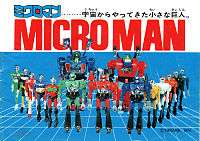
In an attempt to “reboot” the toy line—and attract newer, younger consumers—Takara created the New Microman series which essentially “erased” the backstory/history of all of the toy lines that preceded it. While new figures would be released that superficially looked similar to the older, classic Microman figures their backstory/history was completely different. Additionally the focus of the line switched from the action figures themselves, to the toys and related “robots” themselves.[6][40][41]
New Microman (1981)
While a line of new Microman 3.75-inch-tall (9.5 cm) figures were released for the 1980 New Microman line, their backstory/history was completely different from the figures that preceded them in the classic Microman line. Instead of each figure type containing 3 to 4 different color variants, there were now simply only 10 Microman figures that all came in similarly molded capsules. And variations in color on any particular figure type was simply an arbitrary choice without any naming or character backstory changes. A greater focus was now on the “toys” such as the Micro Robot series of toys as well as larger robot-oriented playsets.[42][43]
Micro Robot (1982)
Takara’s focus of the 1982 line was on the new Micro Borg and Micro Robot toys as evidenced by the fact that absolutely no new 3.75-inch-tall (9.5 cm) figures being released for individual sale that year. While—for example—the Micro Robot W Box Set came with a New Microman M004 Eiji (Blue) figured, these figures were only available as bonuses in a box set and not on their own as individual figures.[44][45]
Micro Change (1983)
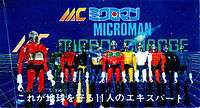
In 1983, Takara introduced a new kind of Microman toy line called Micro Change. The Micro Change toys were seemingly ordinary items—such as cassette tapes, a microscope, watches and even guns—that could transform themselves and “change” into other forms to help Microman in their fight against the Acroyears. While the focus of the line had clearly shifted away from the original Microman figures, Takara did release one last figure dubbed, Salam (M011).[46][47]
Micro Change to Transformers (1984)

1984 saw more releases in the Micro Change line of toys but also saw the end of the Microman action figure line itself with no new figures—not even bonus “gift set” pack-ins—released that year. And after seeing the success Hasbro had combining Takara’s Diaclone and Micro Change line into the Transformers in the U.S. market, Takara decided to end both the Diaclone and Micro Change toy lines and instead focus their efforts on releasing their own Japanese versions of the Transformers.[14][15][16][48]
New Microman 3.75-inch-tall (9.5 cm) Action Figures (1981-1984)
Below is a basic overview list documenting New Microman 3.75-inch-tall (9.5 cm) action figure releases from 1981 to 1984. This is not meant to be a comprehensive list of all New Microman action figure releases/variants but rather a high-level overview of Takara’s 3.75-inch-tall (9.5 cm) New Microman line offerings.[6][41]
| ID | Name | Type | 1st Color | 2nd Color | Opacity | Material | Size/Scale | Body Type | Date |
|---|---|---|---|---|---|---|---|---|---|
| M001 | Arom | Green | Clear | Plastic | 3.75-inch (9.5 cm) | M10X | 1981 | ||
| M002 | Iriya | Red | White | Solid | Plastic | 3.75-inch (9.5 cm) | M11X | 1981 | |
| M003 | Uri | Black | Yellow | Solid | Plastic | 3.75-inch (9.5 cm) | M12X | 1981 | |
| M004 | Eiji | Blue | Black | Solid | Plastic | 3.75-inch (9.5 cm) | M15X | 1981 | |
| M005 | Oruga | Red | White | Solid | Plastic | 3.75-inch (9.5 cm) | M17X | 1981 | |
| M006 | Kamui | Yellow | Black | Solid | Plastic | 3.75-inch (9.5 cm) | M23X | 1981 | |
| M007 | Kirk | White | Blue | Solid | Plastic | 3.75-inch (9.5 cm) | M25X | 1981 | |
| M008 | Cleo | Orange | Black | Solid | Plastic | 3.75-inch (9.5 cm) | M26X | 1981 | |
| M009 | Kenji | Green | Black | Solid | Plastic | 3.75-inch (9.5 cm) | M27X | 1981 | |
| M010 | Corona | Blue | Black | Solid | Plastic | 3.75-inch (9.5 cm) | M28X | 1981 | |
| M011 | Saram | Black | Orange | Solid | Plastic | 3.75-inch (9.5 cm) | M16X | 1983 | |
| M011 | Saram | Blue | White | Solid | Plastic | 3.75-inch (9.5 cm) | M16X | 1983 | |
| M011 | Saram | Light Blue | Black | Solid | Plastic | 3.75-inch (9.5 cm) | M16X | 1983 | |
| M011 | Saram | Red | Black | Solid | Plastic | 3.75-inch (9.5 cm) | M16X | 1983 | |
Microman 21 Series (1996-1997)
From 1996 to 1997—about 12 years after the New Microman line ended in 1984—a small Japanese hobby toy company named Romando acquired a provisional license from Takara to reissue vintage Microman figures. This series was known as the Microman 21 series since the release of these reissues coincided with the 21st anniversary of the original Microman series. Action figures reissued as a part of the Microman 21 series were figures in the Microman Command (M15x), Microman Command (M16x), Microman Rescue (M25x), Micro Knight MC-X, Spy Magician (M13X) lines of figures.[49]
Micro Millennium Series (1998-2003)
In 1999 Takara—for the first time since 1984—produced whole new line of Microman toys as well as officially reissued classic Microman figures. The new Microman series was divided into two distinct lines: the Magne Powers and LED Powers series and the Replica Microman series based on the success of Romando’s previous reissues under their brand name.[50][51]
Replica Microman (1998-2003)
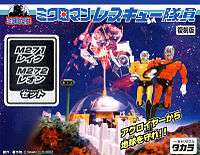
The Replica Microman series was mainly aimed at adult collectors and older fans of the original toy line. This series launched in 1998 with the Microman Founder (M10X) series which reissued the Microman (M10X) figures. That release was soon followed by the reissue of many other classic Microman figures such as Acroyear (A30X), Spy Magician (M14X), Lady Command (M18X) and others. In addition to reissuing versions that adhered to the original, vintage Microman color combinations, Takara also released several limited edition, newly created color variants—and even gave them new Microman character names and designations—to add to the canon of the old series.[52]
As the series progressed in the 2000s Takara continued to release more Replica Microman reissues as well as even more limited edition and exclusive color variants. While increasing variety of available product, this resulted in the Microman market becoming saturated with so many unsold, variants that by 2001 Takara decided to significantly scale back the release of the Replica Microman. By 2003 the Replica Microman series continued to put out releases but only on a very limited basis and mainly through Takara’s e-Hobby Shop.[53][54][55]
Magne Powers & LED Powers (1998-2000)
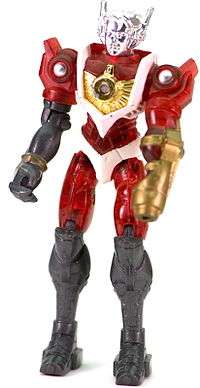
On December 26, 1998 Takara officially launched he Magne Powers series which was followed in 2000 by the companion LED Powers series. The Magne Powers series and LED Powers series were designed for children with brand new toy designs and a new story line which included—for the first time in Microman history—a Microman anime series. In addition to the anime, Takara also commissioned manga serial for Comic BomBom magazine.[56][57][58]
These new toy lines achieved only a mild success with children and even less with adult collectors who felt the new series was far too different from the old, vintage Microman line—especially with the new 8-centimetre-tall (3.1 in) sizing and limited articulation—to fit in with their vintage pieces. By 2000, Takara—which was dealing with financial issues—reduced their new LED Powers series to just a few dozen of toys and canceled the Microman anime series as well as the manga in Comic BomBom magazine. Soon afterwards Takara would put all of their new Microman properties on an indefinite hiatus.[59]
Microman Force Series (2003-2007)
In 2003 Takara decided to test Microman market again with a brand new—but relatively small in number and scope—series of action figures called Microman 2003 which was aimed more towards the collectors and older fans.[60][61]
In the late 2000s, Takara expanded the overall Microman brand and Microman 2003 line to include various licensed brands, including Batman (both comic-based and from Batman Begins), Superman (both comic-based and from Superman Returns), Evangelion, Street Fighter, Godzilla, Alien vs Predator and Kinnikuman. A Spider-Man toy was announced at one point and a photograph of a prototype does exist. However, the figure was never produced; its product number eventually went to one of the Predator figures.[62][63][64]
Microman toy line influence outside Japan
Micronauts (1976-1980)
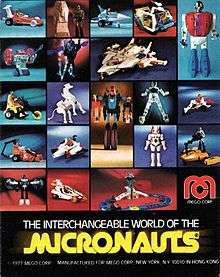
In the 1970s Mego in the U.S. acquired the license for some of Takara’s Microman 3.75-inch-tall (9.5 cm) toys—designs, articulation and modeling—and released them in the United States as the Micronauts. Mego manufactured and marketed Micronaut toys from 1976 to 1980 but discontinued the Micronauts line in 1980 prior to the company’s bankruptcy and dissolution in 1982. But years after Mego’s demise other toy companies—such as Palisades Toys and SOTA (State of the Art) Toys—have attempted to revive the toy line over the years.[65][66]
Transformers (1984-present)
In 1981 Takara produced a new Microman line appropriately called New Microman. A few years later—in 1983—Takara launched a new Microman series within the New Microman line dubbed Micro Change. The line featured toys that were seemingly ordinary items—such as cassette tapes, microscopes, watches and even guns—that could transform themselves and “change” into other forms to help Microman in their fight against the Acroyears.[43]
In 1984 Hasbro acquired the license for the transforming object toys from Takara’s Micro Change toy line as well as similar transforming Takara toys in the Diaclone toy line and the two were combined by Hasbro to create the Transformers toyline.[14][15][48]
Below is a table showing which Transformers were based on which Micro Change toys and their variants:
| Transformers (Hasbro) | Microman/Micro Change (Takara) | ||||
|---|---|---|---|---|---|
| Name | Affiliation | ID | Name | Variant | Release Date |
| Frenzy | Decepticon | MC-01 | Micross | Blue | 1983 |
| Frenzy | Decepticon | MC-01 | Micross | Red | 1983 |
| Ravage | Decepticon | MC-02 | Jaguar | 1983 | |
| Laserbeak | Decepticon | MC-03 | Condor | 1983 | |
| Cliffjumper | Autobot | MC-04 | Mini Car Robo | 01 Porsche Turbo 924 | 1983 |
| Bumper | Autobot | MC-04 | Mini Car Robo | 02 Familia 1500 XG | 1983 |
| Bumblebee | Autobot | MC-04 | Mini Car Robo | 03 Volkswagen Beetle | 1983 |
| Gears | Autobot | MC-04 | Mini Car Robo | 04 4WD | 1983 |
| Brawn | Autobot | MC-04 | Mini Car Robo | 05 Jeep | 1983 |
| Windcharger | Autobot | MC-04 | Mini Car Robo | 06 Transam | 1983 |
| Huffer | Autobot | MC-04 | Mini Car Robo | 07 Truck | 1983 |
| Reflector | Decepticon | MC-05 | Camera Robo Microx | 1983 | |
| Soundwave | Decepticon | MC-10 | Cassette Man | 1983 | |
| Megatron | Decepticon | MC-13 | Gun Robo Walther P-38 U.N.C.L.E. | 1983 | |
| Eggbot (Beast Wars) | Decepticon (Predacon) | MC-14 | Metal Man | 1984 | |
| Dark Eggbot (Beast Wars) | Decepticon (Predacon) | MC-14 | Metal Man | 1984 | |
| Pulse (Binocular Transformer)[67] | Decepticon | MC-19 | Binocular Robo Scope Man | 1984 | |
| Perceptor | Autobot | MC-20 | Microscope Robo Micro Scope | 1984 | |
| Blaster | Autobot | MC-21 | Radi-Cassette Robo | 1984 | |
Microman related anime & manga
Microman Kodansha TV Magazine Manga (1978-79)

In 1977 TV Magazine—a children’s oriented magazine published by Kodansha Ltd.—began publishing an official, Takara approved serialized Microman manga drawn by well-known manga artist Yoshihiro Moritou. This serialized manga was compiled into six volumes released from 1978 to 1979. Additionally, a set of 30 Menko cards featuring Moritou’s manga versions of Microman characters and vehicles was released during that period as well.[68][69][70]
Microman Secret File Volume 1 Catalog and Manga (1984)

By 1984 Takara was continuing the trend of focusing their New Microman line away from the core 3.75-inch-tall (9.5 cm) Microman action figures to robots and other items. Specifically, their new focus was on their line of transformable items in the Micro Change line. Technically Microman Secret File Volume 1 was not a traditional, stand-alone manga one could purchase on their own; it was a combination catalog and manga that was packaged with a few of the new toys in the 1984 Micro Change toy line such as MC-19: Binocular Robo Scope Man. Its purpose was to establish the new direction of the Microman toy line and place the new Micro Change line in proper context within the larger Microman universe. The manga portion of the Microman Secret File Volume 1 contained artwork by Yoshihiro Moritou; the manga artist who created the original Kodansha TV Magazine manga in the 1970s.[71][72][73][74]
That said, Hasbro’s new Transformers toy line—and related storyline—would soon supersede many of the concepts and ideas presented in Microman Secret File Volume 1. So this catalog and manga combination serves as unique glimpse into what direction the Microman line might have gone had Hasbro and the Transformers concept not come along.[71]
Microman: The Small Giant Comic BomBom Manga (1998-1999)
From October 1998 to December 1999 Comic BomBom serialized a new manga based on Takara’s new 1998 Magne Powers & LED Powers Microman toy lines drawn by manga artist Hisashi Matsumoto. This manga was subsequently compiled into stand-alone volumes and released by Kodansha Ltd. The plot focused on a school boy who receives an unexpected package that contains five small action-figures inside that—surprisingly—begin to move on their own and start to talk to him. They introduce themselves as Microman hailing from the planet “Micro Earth” and were sent to Earth to help save the planet.[75][76]
Microman: The Small Giant Studio Pierrot Anime (1999)
The 1999 anime adaption by Studio Pierrot is based on the toys and the manga created by Hisashi Matsumoto and serialized in Comic BomBom. The series ran from January 4, 1999 to December 17, 1999 on TV Tokyo and was subsequently released on VHS and DVD by Pioneer LDC. A companion theatrical movie based on the Studio Pierrot TV anime series was released in 1999 as well.[77][78][79][80]
References
- 1 2 Lorphanpaibul, Paul (4 June 2015). "Classic Microman - Original Microman Series". Microman Forever. Retrieved 4 June 2015.
- 1 2 Calleros, Albert (30 April 2006). "The Micronaut Toyline Tree". Hello Micro. Retrieved 4 June 2015.
- 1 2 Lorphanpaibul, Paul (4 June 2015). "Micro Heritage - Takara Henshin Cyborg Series". Microman Forever. Retrieved 4 June 2015.
- 1 2 Vigneau, Tom (4 June 2015). "History of Microman - Part 1: In the Beginning". Tom's Microman Zone. Archived from the original on 25 September 2000. Retrieved 4 June 2015.
- ↑ Institute, Microman; Takara (27 August 2004). Microman Chronicle — Since 1974-2004 (ミクロマンクロニクルム - SINCE 1974~2004) (in Japanese). Jive. ISBN 9784902314724. Retrieved 5 June 2015.
- 1 2 3 Igarashi, Kōji (November 1999). The Official Guide of Takara SF Land (タカラSFランド大全集 タカラ創立45周年記念 変身サイボーグ ミクロマン ダイアクロン) (in Japanese). Kodansha. ISBN 9784063300864. Retrieved 7 June 2015.
- ↑ "VINTAGE VIEW: Micronauts Time Traveler (1976)". That Figures. 17 February 2011. Retrieved 4 June 2015.
- ↑ Clements, Zane (2 July 2013). "Skooldays: Retro - Micronauts". Skooldays. Retrieved 4 June 2015.
- ↑ NoisyDvL5 (13 May 2010). "Most Requested Figures: Micronauts". IAT: It’s All True. Retrieved 4 June 2015.
- ↑ Lorphanpaibul, Paul (4 June 2015). "MicroHeritage - Micrnauts". Microman Forever. Retrieved 4 June 2015.
- ↑ Calleros, Albert (30 April 2006). "Micronaut Father Figures". Hello Micro. Retrieved 4 June 2015.
- ↑ Larsen, Erik (1 December 2006). "History of the Micronauts". Micro Outpost. Retrieved 4 June 2015.
- ↑ "Micronauts - Mego (1976-1982)". The Action Figure Archive. 4 June 2015. Retrieved 4 June 2015.
- 1 2 3 Lorphanpaibul, Paul (4 June 2015). "New Microman Series - 1984 Transformers". Microman Forever. Retrieved 4 June 2015.
- 1 2 3 "Micro Change - Transformers Wiki". Transformers Wiki. 18 April 2011. Retrieved 5 June 2015.
- 1 2 "Microman Micro-Change toylist (1983-1984)". The Pre-Transformer Page. 19 September 2007. Retrieved 5 June 2015.
- ↑ Vigneau, Tom (8 June 2015). "The Complete Microman Timeline - Part 1: Classic Microman". Tom's Microman Zone. Archived from the original on 18 December 2000. Retrieved 8 June 2015.
- ↑ Institute, Microman; Takara (27 August 2004). Microman Chronicle — Since 1974-2004 (ミクロマンクロニクルム - SINCE 1974~2004) (in Japanese). Jive. pp. 6–96. ISBN 9784902314724. Retrieved 5 June 2015.
- ↑ Institute, Microman; Takara (27 August 2004). Microman Chronicle — Since 1974-2004 (ミクロマンクロニクルム - SINCE 1974~2004) (in Japanese). Jive. pp. 6–8. ISBN 9784902314724. Retrieved 5 June 2015.
- ↑ Lorphanpaibul, Paul (4 June 2015). "Original Microman Series - 1974 Microman Zone". Microman Forever. Retrieved 4 June 2015.
- ↑ Institute, Microman; Takara (27 August 2004). Microman Chronicle — Since 1974-2004 (ミクロマンクロニクルム - SINCE 1974~2004) (in Japanese). Jive. pp. 9–23. ISBN 9784902314724. Retrieved 5 June 2015.
- ↑ Lorphanpaibul, Paul (4 June 2015). "Original Microman Series - 1975 Project Victory". Microman Forever. Retrieved 4 June 2015.
- ↑ Institute, Microman; Takara (27 August 2004). Microman Chronicle — Since 1974-2004 (ミクロマンクロニクルム - SINCE 1974~2004) (in Japanese). Jive. pp. 24–27. ISBN 9784902314724. Retrieved 5 June 2015.
- ↑ Lorphanpaibul, Paul (4 June 2015). "Original Microman Series - 1976 MAT & Spy Magician". Microman Forever. Retrieved 4 June 2015.
- ↑ Institute, Microman; Takara (27 August 2004). Microman Chronicle — Since 1974-2004 (ミクロマンクロニクルム - SINCE 1974~2004) (in Japanese). Jive. pp. 50–60. ISBN 9784902314724. Retrieved 5 June 2015.
- ↑ Lorphanpaibul, Paul (4 June 2015). "Original Microman Series - 1977 Microman Command". Microman Forever. Retrieved 4 June 2015.
- ↑ Institute, Microman; Takara (27 August 2004). Microman Chronicle — Since 1974-2004 (ミクロマンクロニクルム - SINCE 1974~2004) (in Japanese). Jive. pp. 61–70. ISBN 9784902314724. Retrieved 5 June 2015.
- ↑ Lorphanpaibul, Paul (4 June 2015). "Original Microman Series - 1978 Police Keeper & Hoodman". Microman Forever. Retrieved 4 June 2015.
- ↑ Institute, Microman; Takara (27 August 2004). Microman Chronicle — Since 1974-2004 (ミクロマンクロニクルム - SINCE 1974~2004) (in Japanese). Jive. pp. 71–75. ISBN 9784902314724. Retrieved 5 June 2015.
- ↑ Lorphanpaibul, Paul (4 June 2015). "Original Microman Series - 1979 Rescue Command Microman". Microman Forever. Retrieved 4 June 2015.
- ↑ Institute, Microman; Takara (27 August 2004). Microman Chronicle — Since 1974-2004 (ミクロマンクロニクルム - SINCE 1974~2004) (in Japanese). Jive. pp. 76–77. ISBN 9784902314724. Retrieved 5 June 2015.
- ↑ Lorphanpaibul, Paul (4 June 2015). "Original Microman Series - 1980 Microman Punch & Blizzard". Microman Forever. Retrieved 4 June 2015.
- ↑ Microman Mook (Police Keeper) (in Japanese). Takara. 1978.
- ↑ Microman Mook 2 (Rescue Command) (in Japanese). Takara. 1979.
- ↑ Sashida, Minoru (21 June 2007). "Microman Maniacs". Oriental Technology. Retrieved 8 June 2015.
- ↑ Sashida, Minoru (8 June 2015). "Acroyear". Hatena Keyword. Retrieved 8 June 2015.
- ↑ Aoyama, Kunio (16 June 2005). "Microman". Space Advertising Fighter. Retrieved 8 June 2015.
- ↑ Suzukixx, Z (23 September 2001). "Microman Database". Aurkumbell Studio. Retrieved 8 June 2015.
- ↑ "Mini Knowledge 1979". Alpha-H7 Laboratory. 29 August 2011. Retrieved 8 June 2015.
- ↑ Vigneau, Tom (8 June 2015). "The Complete Microman Timeline - Part 2: New Microman". Tom's Microman Zone. Archived from the original on 24 January 2001. Retrieved 8 June 2015.
- 1 2 Institute, Microman; Takara (27 August 2004). Microman Chronicle — Since 1974-2004 (ミクロマンクロニクルム - SINCE 1974~2004) (in Japanese). Jive. pp. 98–128. ISBN 9784902314724. Retrieved 5 June 2015.
- ↑ Institute, Microman; Takara (27 August 2004). Microman Chronicle — Since 1974-2004 (ミクロマンクロニクルム - SINCE 1974~2004) (in Japanese). Jive. pp. 98–107. ISBN 9784902314724. Retrieved 5 June 2015.
- 1 2 Lorphanpaibul, Paul (4 June 2015). "New Microman Series - 1981 New Microman". Microman Forever. Retrieved 4 June 2015.
- ↑ Institute, Microman; Takara (27 August 2004). Microman Chronicle — Since 1974-2004 (ミクロマンクロニクルム - SINCE 1974~2004) (in Japanese). Jive. pp. 108–109. ISBN 9784902314724. Retrieved 5 June 2015.
- ↑ Lorphanpaibul, Paul (4 June 2015). "New Microman Series - 1982 Micro Robot & Micro Borg". Microman Forever. Retrieved 4 June 2015.
- ↑ Institute, Microman; Takara (27 August 2004). Microman Chronicle — Since 1974-2004 (ミクロマンクロニクルム - SINCE 1974~2004) (in Japanese). Jive. pp. 110–112. ISBN 9784902314724. Retrieved 5 June 2015.
- ↑ Lorphanpaibul, Paul (4 June 2015). "New Microman Series - 1983 Micro Change". Microman Forever. Retrieved 4 June 2015.
- 1 2 Furman, Simon (24 June 2004). Transformers: The Ultimate Guide. Dorling Kindersley (DK) Publishing Inc. p. 62. ISBN 1-4053-0461-8.
- ↑ Lorphanpaibul, Paul (4 June 2015). "Microman 21 Series - Romando Microman 21 (Two-One) - Series 1996-1997". Microman Forever. Retrieved 4 June 2015.
- ↑ Institute, Microman; Takara (27 August 2004). Microman Chronicle — Since 1974-2004 (ミクロマンクロニクルム - SINCE 1974~2004) (in Japanese). Jive. pp. 142–192. ISBN 9784902314724. Retrieved 5 June 2015.
- ↑ Lorphanpaibul, Paul (4 June 2015). "Micro Millennium - Return of Microman 1999-2003". Microman Forever. Retrieved 4 June 2015.
- ↑ Lorphanpaibul, Paul (4 June 2015). "1999 - Replica Microman Series - Chronology". Microman Forever. Retrieved 4 June 2015.
- ↑ Lorphanpaibul, Paul (4 June 2015). "2000 - Replica Microman Series - Chronology". Microman Forever. Retrieved 4 June 2015.
- ↑ Lorphanpaibul, Paul (4 June 2015). "2001 - Replica Microman Series - Chronology". Microman Forever. Retrieved 4 June 2015.
- ↑ Lorphanpaibul, Paul (4 June 2015). "2002 - Replica Microman Series - Chronology". Microman Forever. Retrieved 4 June 2015.
- ↑ Institute, Microman; Takara (27 August 2004). Microman Chronicle — Since 1974-2004 (ミクロマンクロニクルム - SINCE 1974~2004) (in Japanese). Jive. pp. 142–176. ISBN 9784902314724. Retrieved 5 June 2015.
- ↑ Lorphanpaibul, Paul (4 June 2015). "Microman Magne Power - 1999 Series 1 - Magne Microman". Microman Forever. Retrieved 4 June 2015.
- ↑ Lorphanpaibul, Paul (4 June 2015). "Microman LED Powers - 2000 Series 4 - Laser Microman". Microman Forever. Retrieved 4 June 2015.
- ↑ Lorphanpaibul, Paul (4 June 2015). "Microman LED Powers - 2000 Series 6 - Shining Tector". Microman Forever. Retrieved 4 June 2015.
- ↑ Institute, Microman; Takara (27 August 2004). Microman Chronicle — Since 1974-2004 (ミクロマンクロニクルム - SINCE 1974~2004) (in Japanese). Jive. pp. 210–219. ISBN 9784902314724. Retrieved 5 June 2015.
- ↑ Lorphanpaibul, Paul (4 June 2015). "Microman 2003 Series - Micro Size Action Figure Series - Micro Force (5/2003) & Micro Force 2nd Run (2/2004)". Microman Forever. Retrieved 4 June 2015.
- ↑ Lorphanpaibul, Paul (4 June 2015). "Microman 2004 Series - Microman Force Series". Microman Forever. Retrieved 4 June 2015.
- ↑ Lorphanpaibul, Paul (4 June 2015). "Microman 2005 Series - Microman Series". Microman Forever. Retrieved 4 June 2015.
- ↑ Lorphanpaibul, Paul (4 June 2015). "Microman 2006 Series - Microman Series". Microman Forever. Retrieved 4 June 2015.
- ↑ Rooney, Bob (2011). "RTM Spotlight on: Micronauts". Raving Toy Maniac. Retrieved 4 June 2015.
- ↑ "Mego Micronauts". MEGO Museum. 4 June 2015. Retrieved 4 June 2015.
- ↑ "Pulse". Transformers Wiki. 25 May 2016. Retrieved 30 June 2016.
- ↑ Lorphanpaibul, Paul (5 June 2015). "Micro Archive - Original Microman (1974-1984)". Microman Forever. Retrieved 5 June 2015.
- ↑ Lorphanpaibul, Paul (5 June 2015). "Micro Archive 1974-1984 - TV Magazine Present - Microman Collectible Cards (c.1978?)". Microman Forever. Retrieved 5 June 2015.
- ↑ Wilkinson, Bryan (6 March 2015). "Micro Change: Microman Secret File (part 3)". “Crew of Spirited Boys” Microman Club. Retrieved 5 June 2015.
- 1 2 Wilkinson, Bryan (6 March 2015). "Micro Change: Microman Secret File (part 1)". “Crew of Spirited Boys” Microman Club. Retrieved 5 June 2015.
- ↑ Decepticon, Heroic (16 May 2010). "Pre-Transformers Microman Secret File catalogue". Heroic Decepticon. Retrieved 5 June 2015.
- ↑ unexistance (22 February 2014). "Micro Change - Backstory". MicroMan-32. Retrieved 5 June 2015.
- ↑ "Microman Micro-Change Catalog Scans". The Pre-Transformer Page. 19 September 2007. Retrieved 6 June 2015.
- ↑ Baka Updates (5 June 2015). "Chiisana Kyojin Microman". Baka Updates Manga. Retrieved 5 June 2015.
- ↑ Institute, Microman; Takara (27 August 2004). Microman Chronicle — Since 1974-2004 (ミクロマンクロニクルム - SINCE 1974~2004) (in Japanese). Jive. pp. 193–208. ISBN 9784902314724. Retrieved 5 June 2015.
- ↑ "Studio Pierrot's Chiisana Kyōjin Microman Website". Studio Pierrot. 4 June 2015. Retrieved 4 June 2015.
- ↑ Chiisana Kyōjin Microman (anime) at Anime News Network's encyclopedia
- ↑ Chiisana Kyōjin Microman: Daigekisen! Microman VS Saikyō Senshi Gorgon (film) at Anime News Network's encyclopedia
- ↑ Chiisana Kyojin Microman Movie - Daigekisen! Microman vs Saikyou Senshi Gorgon on YouTube
External links
- Microman Forever Paul Lorphanpaibul’s English language Microman fan site.
- Microman Maniax Minoru Sashida’s Japanese language Microman fan site.
- Microman Century Seven A Japanese language Microman fan site.
- Alpha-H7 Laboratory A Japanese language Microman fan site; index is available in English.
- Space Advertising Fighter: Microman Kunio Aoyama’s Japanese language Microman fan site.
- Aurkumbell Studio: Microman Database Z Suzukixx’s Japanese language Microman fan site.
- Micropola Ron Pringle’s English language Micronauts/Microman fan site.
- “Crew of Spirited Boys” Microman Club An English-language site focused on out-of-print/ephemeral media from the Microman.
- Microman/Micronauts Fans Facebook Group The world’s largest English language online community of Micronauts/Microman fans.
- Yahoo!: Groups: Micropolis_Embassy An English language Micronauts/Microman collector group.